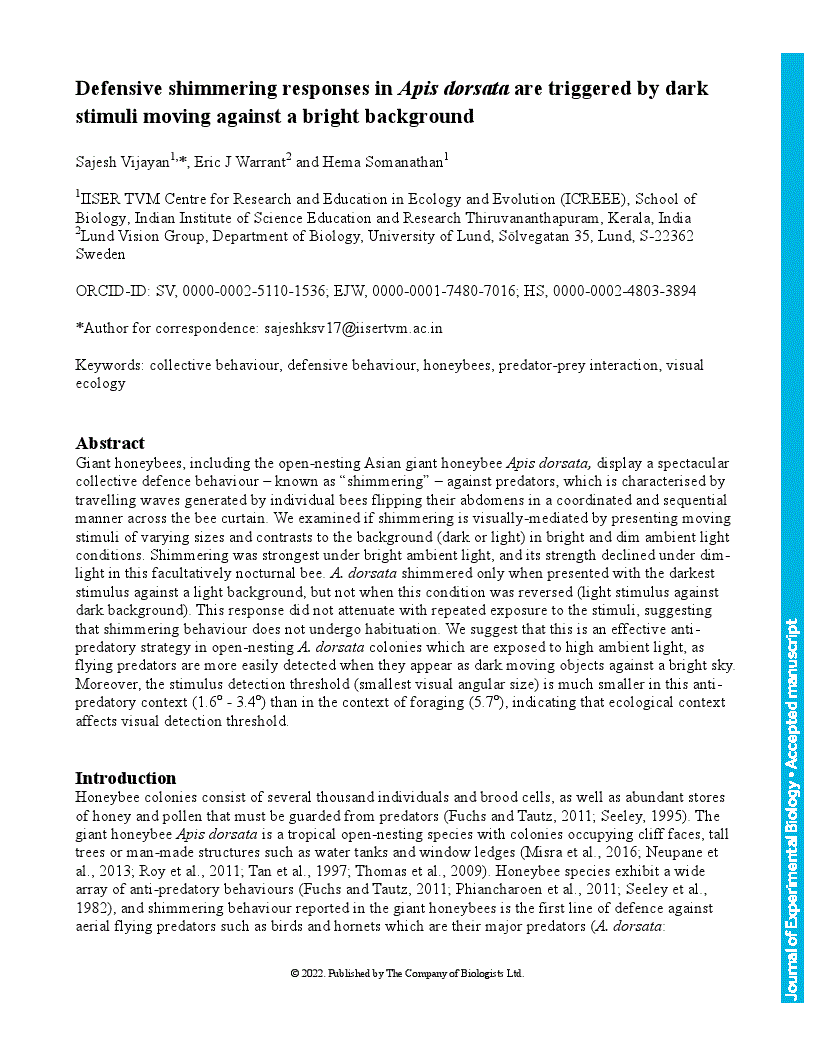Giant honeybees, including the open-nesting Asian giant honeybee Apis dorsata, display a spectacular collective defence behaviour – known as “shimmering” – against predators, which is characterised by travelling waves generated by individual bees flipping their abdomens in a coordinated and sequential manner across the bee curtain. We examined if shimmering is visually-mediated by presenting moving stimuli of varying sizes and contrasts to the background (dark or light) in bright and dim ambient light conditions. Shimmering was strongest under bright ambient light, and its strength declined under dim-light in this facultatively nocturnal bee. A. dorsata shimmered only when presented with the darkest stimulus against a light background, but not when this condition was reversed (light stimulus against dark background). This response did not attenuate with repeated exposure to the stimuli, suggesting that shimmering behaviour does not undergo habituation. We suggest that this is an effective anti-predatory strategy in open-nesting A. dorsata colonies which are exposed to high ambient light, as flying predators are more easily detected when they appear as dark moving objects against a bright sky. Moreover, the stimulus detection threshold (smallest visual angular size) is much smaller in this anti-predatory context (1.6o - 3.4o) than in the context of foraging (5.7o), indicating that ecological context affects visual detection threshold.
Defensive shimmering responses in Apis dorsata are triggered by dark stimuli moving against a bright background
- Award Group:
- Funder(s): Council of Scientific and Industrial Research, India
- Funder(s):
- Award Group:
- Funder(s): Indian Insititute of Science Education and Research Thiruvananthapuram
- Funder(s):
- Award Group:
- Funder(s): Vetenskapsrdet
- Award Id(s): 2016-04014
- Funder(s):
Currently Viewing Accepted Manuscript - Newer Version Available
Sajesh Vijayan, Eric J. Warrant, Hema Somanathan; Defensive shimmering responses in Apis dorsata are triggered by dark stimuli moving against a bright background. J Exp Biol 2022; jeb.244716. doi: https://doi.org/10.1242/jeb.244716
Download citation file:
Advertisement
2023 JEB Outstanding Paper Prize shortlist and winner

The JEB Editors are delighted to announce the shortlisted authors for the 2023 JEB Outstanding Paper Prize. Read the winning paper - Tiny spies: mosquito antennae are sensitive sensors for eavesdropping on frog calls - by Hoover Pantoja-Sanchez and Brian Leavell from Ximena Bernal's lab at Purdue University, USA.
JEB Science Communication Workshop for ECRs

If you’re an early-career researcher interested in science communication and are attending the SEB Annual Conference in Prague this summer, come a day early and join the JEB Editors at a sci comm workshop to learn the key writing skills needed to promote your research to a broad audience beyond your peers (1 July at 14.30-17.30). Places are limited to 24 attendees, and applicants should apply through the SEB registration page by 30 April 2024.
Bridging the gap between controlled conditions and natural habitats in understanding behaviour

Novel technologies enable behavioural experiments with non-model species, in naturalistic habitats and with underexplored behaviours. In their Commentary, Scholz and colleagues discuss how to obtain a deeper understanding of the natural ecology and lifestyle of study animals.
Beluga metabolic measures could help save species

To help save animals from extinction, it’s important to understand what each species needs to survive. This led Jason John et al. to measure the metabolic rates of captive belugas to develop a ‘fish calculator’ showing that the whales need to eat ~23 salmon per day.
ECR Workshop on Positive Peer Review

Are you an ECR looking for tips on how to write concise, astute and useful manuscript reviews? If so, join the JEB Editors at a 2-hour JEB-sponsored Workshop on Positive Peer Review at the Canadian Society of Zoologists annual meeting in Moncton on 9 May 2024 at 13.00-15.00. There are 25 spaces for ECRs and selection is first come, first serve. To sign up, check the ECR Workshop box when you register for the CSZ meeting.



